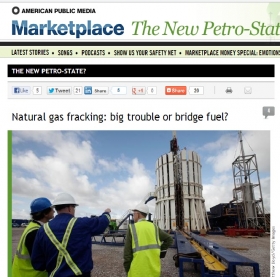You are here
Fractured Friends

HEFN Director Kathy Sessions wrote this blog post.
Environmental philanthropy feels a little embattled right now. Alongside urgent ecological problems and bankrolled political opposition, it also is facing debates over analyses like Theda Skocpol’s report on the cap-and-trade campaign. I hear those outside critiques mirrored in internal funder discussions, often in huddles of like-minded factions.
Funders talk about the climate campaign’s history and its lessons for future investments, mostly in conversation with peers who think similarly. Some worry a lot—and others not nearly enough—about whether environmental grantmakers and their grantees will adapt to changing demographics and cultures. I hear both anguished discussion and scary silence about polarizing views of natural gas. Is it an urgently-needed means of carbon reductions and bridge to clean energy? Or a new chapter of a tragic tale in which green powerbrokers sacrifice allies and communities for a disastrous deal?
To get anywhere close to scale in tackling major environmental problems, environmental philanthropy cannot afford such fractured friendships. The irony is that I see such tangible opportunities now for that community to broaden its base, forge powerful long-term alliances, and leverage resources into dynamic defense of people and planet.
Several public opinion researchers reported at the Environmental Grantmakers Association 2013 Federal Policy Briefing that support for environmental protection is strong among communities linking their health to the environment, and that it is deeper among people of color and younger voters than among white and older voters. This demographic information should be, on the whole, good news. The emerging majorities are already in movements to protect the environment. The problem is, they may not be in “the” environmental movement, nor is much of their engagement being funded through it.
At HEFN, every year we see people whose health is being impacted by environmental hazards mobilize and make things happen, whether philanthropy helps them or not. That is at the heart of the environmental justice movement. Similarly, HEFN’s 2012 national survey of activity on fracking found spontaneous organizing among communities experiencing impacts from drilling activity, including in places where no grantmaking was reported.
We have witnessed big payoffs from even modest investments in toxics community- and constituency-building strength. Outreach to women’s groups taps the viral power of mommy bloggers and unleashes stroller brigades on legislators. Consumer information turns into viral market pressure, voluntary retailer actions and small business support for regulation. Youth organizing sparks leadership and social media innovation. And—through relationships with friends in other funder communities—we see similar broad-based mobilizing around issues like food production, civic participation, social determinants of health, transportation, and land use.
As with the demographics picture, issue-focused organizing is often pushing for social changes that will be helpful for environmental issues and/or is strengthening bases that will naturally favor stronger environmental protection. But these move—and their benefits for green priorities like climate and clean energy—could go much farther, faster, and deeper with help from environmental philanthropy.
To do this, I believe, will require moving past fractured huddles based just on issues or ideologies, into more sustained relationships and power-building among the many friends who all value protecting the environment, people, and communities. We delved into some of this at HEFN’s 2012 annual meeting, discussing how—and whose—power is shaping environmental health and justice outcomes in politics, markets, science, and communities.
Environmental philanthropy as a whole has, in my view, held too narrow a view of what power matters, too limited a view of who has power, and too short-sighted a view of whose power is worth building. Funders focus on specific battles, investing in trusted grantees and alliances with those perceived to have power now to decide those battles. This may be logical through a short-term campaigns lens. But when it alienates friends and starves the broader base needed to sustain long-term progress, it’s problematic.
I do see some environmental funders diversifying their grantee base, whether in terms of geographies, demographics, issues, or social change strategies. While they focus on specific battles, they also think about how to do this in ways that will strengthen groups who will be committed to protecting the environment and communities over the long haul. Many of HEFN’s members, and their colleagues in other affinity groups, are reaching across issue priorities to strengthen connections and collective base-building. But my sense is that most of environmental philanthropy still is heading down a familiar path:
- Developing strategies mostly in closed circles of the already-agreed, with few efforts to reality-test with would-be allies;
- Investing mostly in a few nationally-focused groups historically self-identified as “environmental” with great insider skills but low levels of race, class, and age diversity;
- Designing campaigns as highly centralized, top-down operations, with comparatively little focus on organizing grassroots up or on sharing information virally outward; and
- Prioritizing outreach towards political or industry players, and/or through slick marketing, over building values-based relationships for the long haul.
Continuing down that path runs counter to the possibilities being created as the US becomes more colorful, younger generations ascend, and multi-issue organizing engages more stakeholders in environmentally-protective social change. Doing so risks underestimating, undermining and alienating environmentalism’s expanding base of natural friends.
Power is not just about who has the votes or moneyed influence to pass one bill. There is power in voters and elections, diversified flows of information, consumer pressure, entrepreneurial drive, organizing energy, families’ interests in protecting their health, and moral commitment. Those powers are worth investment.
And there is power in friendships. Friendships can bring different skillsets and connections onto a team. Friendships, good ones, at least, enable us to tolerate honest debate and disagreement about what to do in the short run, while we work together towards common goals for the long run. Philanthropy really needs these kinds of friendships, as it makes decisions about how to dispense its own power.
From our Blog
Upcoming Events
|
Apr 23 2024 Zoom |
Apr 30 2024 Zoom |

